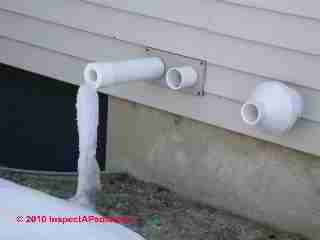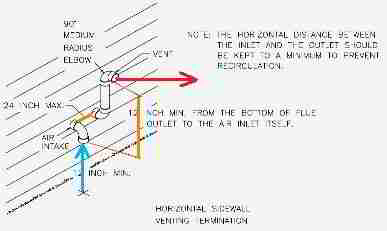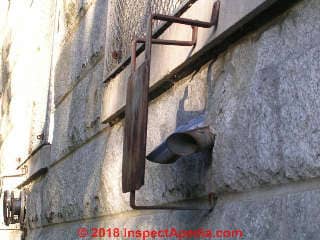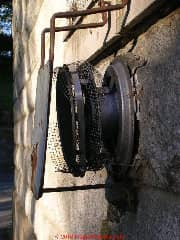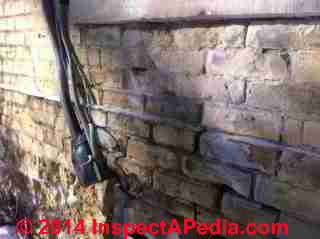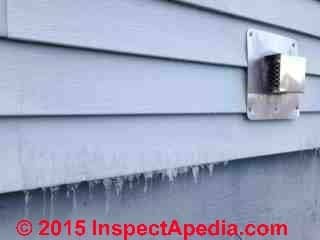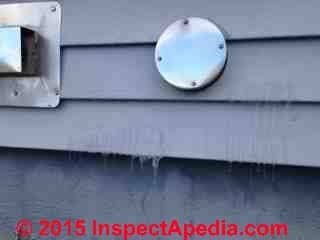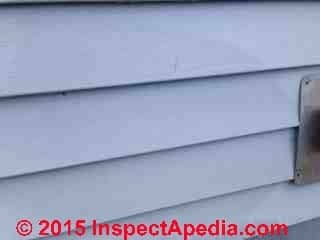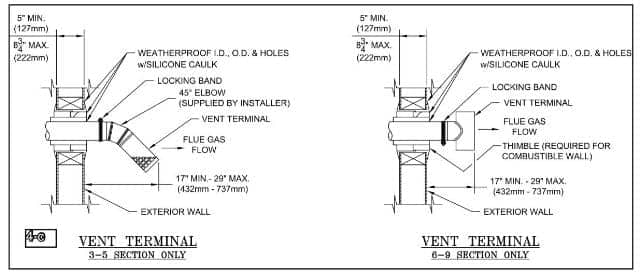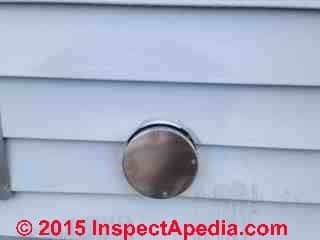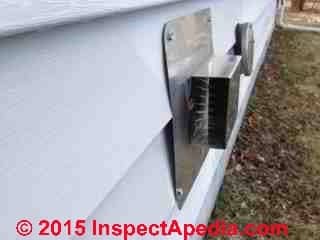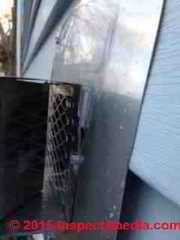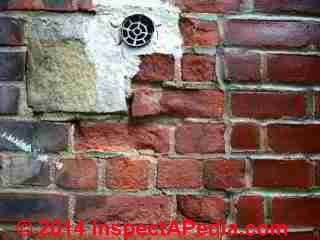 Side Wall & Direct-Venting Heater Installation SNAFUs
Side Wall & Direct-Venting Heater Installation SNAFUs
- POST a QUESTION or COMMENT about the installation or diagnosis of sidewall vent or direct vent chimney or flue exhaust systems for heating appliances and for condensing furnace or boiler sidewall vents
Specifications & Errors in Direct Vent, Side-Wall Vent, & Condensing Boiler or Furnace Vent installations:
This article describes common mistakes found in both side wall vent systems for conventional & mid-range-efficiency heating boilers, furnaces & water heaters and also mistakes in low temperature side wall vent systems used by high efficiency or condensing boilers, furnaces & water heaters.
We include links to example installation specifications for side wall vented hearers from manufacturers of several brands.
InspectAPedia tolerates no conflicts of interest. We have no relationship with advertisers, products, or services discussed at this website.
Direct Vent Exhaust for Heating Flues: Installation & Inspection Questions & Answers
Reader Question: is it ok to install an elbow on the outside plastic direct-vent exhaust to avoid ice problems?
I see by the photo of ice on the exhaust pipe of what looks like a condensing boiler or furnace installation, that the installation is not sloped back into the furnace, or that it may not be high enough.
Can the pipe be best elbowed on the outside, slanted back into the house, while extensions are on the exhaust pipe well above snow levels.
And what about insulation in an unheated crawl space and a heat tape.
Then there are testing for improper gluing of the elbows and round connectors of PVC piping. How should they be tested for no leakages. - Concerned2 11/20/2012
Reply: No
Concerned,
I am nervous about your pipe elbowing in the exterior as I think it violated the manufacturers instructions, and increases the freeze risk too by adding more travel distance through freeze temperature piping - but I may have misunderstood.
Also, if condensate is freezing at the mouth of a horizontal drain through the wall it will still freeze as it passes through a down-pointing elbow.
The pipe needs to be re set to proper slope to fix the freeze problem
Tests for leaks in a PVC condensate drain can be done using pressure fittings and plugs but I doubt anyone does that, relying more on workmanship during installation and inspection for leaks afterwards.
Too I agree that a condensate drain routed through a freezing crawl space would be unsafe. I would not rely on heat tapes, rather the installation sounds off.
Reader follow-up:
I live in B.C. I do not know who was to be held accountable when the installation of my Lennox Pulse was not inspected by the gas inspector, back in 1994.
A trouble area inside the house, just before the exhaust PVC pipe was to go outside, there was placed four connectors, close together, up in the beam or joist area of the house. They did this to have the pipe on the outside 12 inches above snow level, which is not sufficient for this area.
One elbow became detached. No one in the gas industry would come to fix a Lennox Pulse G21, claiming if they did so, it would void the warranties. The installer would not inspect the pipe.
The permit was taken out, but no inspector came to investigate, and there seems to be no one investigating how pvc pipe is installed to a high efficiency gas furnace. I went from 1995-1996, after the detached pipe was noted by guests reporting they were feeling sick in the bedroom above this venting.
The problem was that no one would come because it was Lennox G21 H-EF. The other companies were declaring they did not know how to work on a Pulse, or testing piping or the heat exchanger.
that there were so many elbows in a small area, less than 15 inches, between the beam and the outside house what Code or instructions from the manufacturer were being violated, and how do you deal with those involved?
Rather than fixing the problem on May 3, 2012, another Lennox dealer, instead of my request one straight pipe, a correction of that area, he, too, put in two elbows on the inside area, up in the beams. I asked for a straight pipe and the elbows on the outside of the house.
He left the premises not pressure testing the piping system or the heat exchanger as requested.
He put in 90 percent new replacement piping, when the only area was of less than two feet. He said he did a visual inspection for the heat exchanger, knowing the exchanger was 18 years old, and the new piping could yet have a problem of leakages.
What all codes may have been violated? - Concerned 12/2/12
More from Concerned2:
In British Columbia we do have a licensing and training agency and one that gives out permits and for inspection. This is a private group, operating as a not-for-profit corporation. It is unclear under what Provincial Government Ministry, if any, they are subjected to, if they are doing their duty. It is believed they operate with government funding and fees for permits.
Who can determine if this SSA have any authority on installers, suppliers, manufacturers, and gas service providers for any brand of H-EF, and for testing of safety of a H-EF in the home and on the piping systems used for any and all H-EFs. It would take an experience trades person to understand this act, or an extremely intelligent lawyer. [www.bclaws.ca/EPLibraries/bclaws_new/document/ID/freeside/00_03038_01]
Failure to inspect on original installation of an unknown city building inspector, or gas inspector, Dec. 8, 1994, And the allowance that a requested service of pressure testing was not thought in violation of the due diligence of care owed by a Lennox dealer to a user of the Lennox product.
More from Concerned2:
Failure to inspect on original installation of an unknown city building inspector, or gas inspector, Dec. 8, 1994, And the allowance that a requested service of pressure testing was not thought in violation of the due diligence of care owed by a Lennox dealer to a user of the Lennox product. (this comment is not published until you approve it) [delete]
(Dec 1, 2012) The one site demonstrates a proper pvc venting installation, the other shows an improper system, which was similar to mine. On the inside of my house there were four connectors, or elbows, and one elbow was not properly glued and became detached.
No other firm would touch the work previously done by the Fort St. John Lennox dealer, nor of the current Dawson Creek Lennox Dealer. thermo pride installation of venting pipes - .they are close to the house, high up, and not sticking 12 inches from the house.
Figure 8, page 21 of Thermo Pride's installation instructions vs photo of ice on venting pipe, extending about 12 inches from the house, and not above expected snow levels. - [see sketch above][15]
The inside pvc pipe just before the pipe goes to the outside vent is yet having at least two connectors, a 90 degree and a 45 degree elbow, yet up in the beam area of the house, of less than twelve inches of that area. My crawl space is unheated, and the installation instructions were ignored, in 1994, and now of May 3, 2012, requiring insulation, plus an electrical heating tape, installed for winter use.
Can anyone tell me of what National or International codes were violated, and is there any discipline if the local city inspector or Provincial inspector did not inspect the installation to the directions stated by the manufacturer in printed manuals or how to test PVC piping systems, and, of course, the heat exchanger.
No one is taking any responsibility. All is placed on the homeowner, and we had the least chance to know what was proper, in the past, and even now. Please help.
I would think a lawyer would be required of any violations or risk to the home and people. Thank you for forwarding to those who may be concerned in Canada and the USA.
Reply:
Concerned: note the with respect to clearances between the direct vent and the ground surface, the distance shown is a minimum not a maximum allowable distance. But in relocating the exhaust or intake openings, keep in mind that other safety clearances from windows etc. must still be respected. The instructions to which you refer include the following additional details that address your concerns:
The outlet/inlet of the vent and air intake terminations shall be a minimum of 12 inches above highest anticipated snow level. The vent outlet must be installed a minimum of 12 in. above the air intake inlet.
The combustion air intake shall be installed upwind of the vent outlet when exposed to prevailing winds. [15]
More Unsafe Direct Vent Chimney Details
Below: other strange and terrible driect-vent chimneys we have found:
First what looks like automobile or truck exhaust pipe extensions used as a direct vent flue tdhrough a stone masonry wall.
Second a leaky damaged, direct vent chimney at the same building.
Reader Question: spalling brick wall damage from gas fired heater exhaust
My propane boiler exhausts out at about 18" above grade. I have recently had some issues with it short cycling and possibly some propane has not been burning (sometimes all jets weren't firing.)
While investigating I noticed that the brick is spalling near the exhaust. I had some mortar falling out there when I moved in two years ago, but haven't gotten around to fixing the problem. Now the brick is spalling off also, I don’t think it was doing that before. Any ideas if this could be caused by improper boiler operation?
The vent is 4” type BH stainless single wall, pitched so it higher on the outside, cap does’t protrude far from the brick. However the manufacturer suggests venting so it is pitched down to the outside.
I am thinking of replacing the existing exterior cap with a 90 deg elbow pointing down 8” from wall as suggested by the manufacturer (original one installed by contractor had been broken off, this one installed by previous home owner.)
The boiler is a Smith GV100W, maximum of 84% efficiency. I've attached a picture in case that helps, Thanks. R.M. 1/21/2014
Reply:
A competent onsite inspection by an expert usually finds additional clues that would permit a more accurate, complete, and authoritative answer than we can give by email alone. That said I offer these comments:
As both your photograph (above) and mine (at left) show, exhaust gases can cause spalling brick damage on buildings. Whether the damage appears above or below the vent depends mostly on the direction of exhaust and moisture movement.
You should absolutely follow the manufacturer's vent recommendations. The manufacturer has a great interest in the safe use of their equipment, as do you.
A back-sloped (wrong way) vent on a gas fired appliance risks condensate drain-back into the equipment where it may cause dangerous or expensive rust damage, even risking carbon monoxide leaks. (Be sure you have working CO detectors properly installed in the home).
Watch out: A second consideration is whether or not you have adequate ground clearance. If you are in a freezing climate I'd worry that snow cover can block the exhaust vent - a dangerous condition.
See CARBON MONOXIDE WARNINGS: HOME HEATERS
Finally, I agree that gas exhaust can indeed speed up spalling on brick work, especially on an older building at which the original bricks may be of a softer composition than many modern masonry walls. Perfect combustion of LP or natural gas would produce just water vapor and CO2.
But that water vapor alone, rolling up the wall above the vent, tends to be absorbed by brickwork that then, depending on climate and brick composition, may be softened or may be frost damaged.
Reader Question: gas furnace direct-vent exhaust too close to ground or not protected from snow cover
(Nov 16, 2014) Anonymous said:
Our exhaust to our gas furnace is located at the front of our home very low to the ground.. Our unit is part of a 6 unit building and the front is the only location for this to be installed. Our problem is during the winter months we have to be very careful snow does not cover the opening. Is there some kind of an extension we can use to raise it higher from the ground?
11/28/2014 kevin said:
i have a gas boiler with side wall vents outside the home ,where they are located it happens to be where snow drifts occur and must be cleared frequently, since my in laws are elderly and cannot get out to clear this, is there a way i can build a box around these vents with vent holes cut out ?
Reply:
Kevin
Indeed manufacturers want the side wall vent to be installed above the likely snow height - else the system could be unsafe, even fatal for building occupants.
You might be able to improve conditions by installing a roof of adequate size and height to minimize the snow accumulation. I would FIRST check with the vent manufacturer for their own recommendations. I'd be very wary of building any sort of an enclosure that might constrict vent, air intake, cause system malfunction, etc.
12/5/2014 Reply from reader Concerned2: lack of enforcement of recommended direct vent safety specifications
Concerned 2 said: [OPINION]
Update. Bad original installation on a Lennox Pulse G21Q3-100-3 and poor workmanship skills, thereafter. I had the outside air intake pipe cut off and this has stopped chilly air (-39 F) from coming into the furnace and shutting it down. I have a 1200 ft of unheated crawl space and this seems best to have the intake air into the HEF to be at about 50F. It prevents the water vapor from drawing into the air vent and freezing, too. No chilly air is shutting down the furnace for colder climates that can be -39 C or lower.
I yet have to change the exhaust venting to be over 12 inches above the expected accumulated snow for the Dawson Creek,BC area, the drifting can be up to 5 feet or 60 inches. Many older roof top chimneys were at least that 60 inches tall. I think the system was preparing for global warming. I yet have to have this 20 feet of venting to be insulated inside and outside.
It seems the HEF installers in this colder area have been allowed to reduce the roof top and side venting to dangerous heights (24 inches or less) and this is being ignored by the British Columbia private safety gas authorities, at present.
Few inspections. What is justice when the good of the manufacturer's furnace's installation instructions are ignored or the good in the CSA B149 Codes?
What is justice if the furnace manufacturer never really tested their HEF in the colder climates and approved the six inches close venting systems to allow re circulation of the bad air into the gas and air chamber and shut down the furnace and cause expensive repairs to the control board unit, a cost of close to $1000.00 to repair the furnace.
Others have had similar freeze up but in their city water lines. I now use RV anti-freeze if any of my exhaust venting is freezing up or in the water drip vent. It works. And so does drawing in the crawl space air at 50 F to no more than 80F back into the furnace from a 1200 square footage of crawl space. If you know of any gas codes that support that this is okay, let me know, thank you.
Reader Question: Improper direct vent gas heater installation - icicles hanging from the vent, improper sealing
(Jan 15, 2015) Carole Rowley said:
I have had a new gas system put in that vents out to the side of the building on to the garden and street, It's a private home.
I travel a lot. My neighbors have sent me concerned emails about the fact that all around the exhaust pipe there are icicles forming. obviously attaching themselves to the siding (not wood siding.
I suppose it's some kind of plastic) Usually I only have icicles hanging from the eves. Can this corrode the siding? Has the vent been improperly installed? It sticks out about 3 or 4 inches from the siding.
I did have other problems with the companies installation. I wish I had chosen to go through the chimney but the company suggested it would be more expensive . true?
Then venting system is very noisy - both inside and outside the house.
Thank you for your help.
Burnham_ESC_Direct_Vent_Detailsss.jpg
Reply:
Carole
Watch out: the dangers are more than ice damage to siding. Ice formation at a direct vent gas appliance can ultimately block the vent causing formation of dangerous, even fatal carbon monoxide gas in the building, or loss of heat and concomitant freeze damage to the building.
it's possible that your venting is not sloped properly or not handling condensate properly.
Use our email found at CONTACT at page top or bottom to send me some photos and I can comment further.
Reader Follow-up:
Thank you so much for replying. I’m glad to find someone to trust! I am a single woman home owner and the company that installed the new Gas heating system was negligent in many ways.
Today we had warmer weather so the icicles have mostly melted but you can see a slightly darker tint in the last 3 pictures on the siding where others were. And they went up much higher on the siding on colder days/weeks forming 1 on top of the other sometimes. There are 5 views here.
and
Reply:
I have to say this looks like a rather questionable vent installation at the wall. Simply screwing a flashing atop vinyl siding is hardly weatherproof and invites rain leaks into the wall structure.
And the ice as well as what looks like moisture shadows in your photos suggests to me that equipment is actually venting into the space behind the siding - itself an unsafe condition as we don't know that it's venting with proper draft and we don't know that flue gases can't be re-admitted to the building - a potential carbon monoxide hazard.
I'd start by identifying the brand, model, serial number of the equipment installed, obtaining the installation manuals for each device including the vent systems.
Compare that to what was actually done. Or if you can't find those manuals give me the equipment information and I'll see what I can find.
And tell me the city/state/province/country of this installation.
Reader Follow-up:
My heating boiler is a Burnham ESQ with IQ control system by US Boiler company
model ESC4C (serial 65410825). I don't have the installation or operation manual for my boiler.
And I took more pictures around the intake and out take. The square box is 4 x 4.5 roughly and 2 inches deep. Other round about 2 or 3 inches deep.
Reply:
Burnham's manuals are now found through http://www.usboiler.net/
Here are the user's manual and the installation & operation manuals - these should cover your unit and include venting installation details. I am including an Install/Operate manual for earlier models as I'm not sure the date of yours.
- BURNHAM ESC INSTALLATION & OPERATION MANUAL[PDF] - cited in DIRECT VENTS / SIDE WALL VENTS x, includes these details - Excerpting from the vent connection instructions:
(4) When configuring the ESC for Power Vent (indoor combustion air) install a 45° vent elbow, pointing downward.
(5) Install vent terminal and seal around all exterior openings. - BURNHAM ESC USERS MANUAL [PDF]
- BURNHAM ESC INSTALLATION & OPERATION MANUAL PRE 2012-09 [PDF]
And here is an installation sketch showing details of a proper direct-vent installation for the Burnham ESC gas boiler, excerpted from the first citation given just above.
[Click to enlarge any image]
Watch out: other readers: be sure to follow the instructions for your specific product from its manufacturer.
Reader Questions & Comments on distance between "moisture exhaust vents" and air intake vents for heaters
Question:
(Mar 22, 2015) Jag said:
In my house, the builder installed the gas vent pipe 636, about 25 feet long to exhaust the gasses to one side of the building, where as other side of the house is only about 6 feet far from hot water heater. Why did they waste pipe in extra length or is there any requirement that we must install the exhaust vent with minimum certain length from water tank. Thanks
Reply:
Jag
I don't know - perhaps there was not proper outdoor clearance at the shorter route. What did the installer say in response to this question?
Reader follow-up:
2015/12/07 concerned2 said:
Update. VENTING PROBLEMS TO HEF (the below quotes a CSA standard): gas chamber outside air intake must be further apart than 3 feet from any moisture exhaust gas vent.
The B149 gas and propane code, section 8.3.7 states no moisture exhaust vent should be closer to any air intake vent back to the furnaces air and combustion chamber. All HEF produce water vapors.
My intake air vent was on the wrong side and was five inched apart from the exhaust vent. You can see in the winter the vapors being drawn into the furnace. My crawl space was no heated where the two vents run. No insulation was on them, inside or outside.
The were not above 12 inches of accumulated snow. In this area common safety for roof top or side venting, and of informed consent, should be 50 inches. My furnaces would frequntly go in shut down and on the coldest days.
Any code to take my air into the natural gas chamber in a 1200 sq. Ft. Crawl space for the 100 BTU as it would be warmer than 50 F, but not hotter than about F. I am told this is okay, but have no gas code.
Concerned2 said:
Correction, B149 8.3.7, Jan. 2010, confirmed 2015 states: the gas chamber outside air intake must be further apart than 3 feet from any moisture exhaust gas vent.
Reference:
- Canadian CSA Standard: B149.1S1-07
Supplement No. 1 to
CAN/CSA-B149.1-05, Natural gas
and propane installation code [PDF]
January 2007, Title: Natural gas and propane installation code — originally published January 2005, retrievbed 2015/12/07, original source: http://www.csagroup.org/documents/codes-and-standards/supplements/B149_1S1_EN.pdf
Please contact CSA Information Products Sales or visit www.ShopCSA.ca for information about the CSA Standards Update Service.
Reader Comments, Questions & Answers About The Article Above
Below you will find questions and answers previously posted on this page at its page bottom reader comment box.
Reader Q&A - also see RECOMMENDED ARTICLES & FAQs
On 2021-03-05 by (mod) - Up-opening PVC direct vent on NTI Combination Boiler?
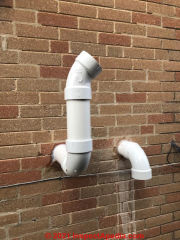 @Eric, I surely never seen a 45 in that position.
@Eric, I surely never seen a 45 in that position.
Normally a vent would be angled uding a 90 so as to not be open to rain and snow.
You can answer this question with authority by taking a look at the installation and operation manual for your specific equipment.
There you will see exactly how it's supposed to be vented.
Let me know what you find.
On 2021-03-05 by Eric
NTI Combi boiler vented out the side of house. I question whether this exhaust end should be 90 degrees instead of 45 degrees. Company that installed says that any rain/snow etc. will drain back to the unit and go down the drain. Every other house I have looked at has 90-degree end- (parallel to side of house). Is this considered a proper installation? Thanks
On 2020-09-26 - by (mod) -
Paul is no single right answer. You need to look at the specifications and instructions from the manufacturer of the specific power vent brand and model
On 2020-09-25 by Paul
How far can I run flue pipe for power vent steam boiler. Burnham
On 2020-06-17 - by (mod) -
Wendell
Im afraid thatva general answer could be unsafe.
To be safe youll want to identify the brand and model heater, then check the manufacturer's venting guidelines.
On 2020-06-16 by Wendell
Can a 95% gas furnace vent down and out a sidewall in crawl space?
On 2018-01-23 by Karl
How high above condensor do you recommend the 90+ vent be?
On 2016-12-27 - by (mod) -
Anon
Please use the search box just above and search InspectApedia for DIRECT VENT CLEARANCES to see these details.
On 2016-12-27 by Anonymous
On a propane boiler in my utility room i would like to vent out the side wall both the fresh air intake and the exhaust?, how far from the roof eves
On 2015-12-08 - by (mod) -
Thanks JAG _ I've added your comments above.
Question: Strong winds may overcome exposed direct vent chimneys or flues for heating appliances?
Concerning sidewall power vent to one of my residential gas furnaces. It is a proper code compliant side vent sloped properly with condensate drain etc. However, it is on a wall exposed to a wide open area - thus winds can be strong against the house. Do I need to install something like an open vent collar to reduce the back pressure variations caused when winds are heavy? - Sack from VA 12/2/12
Reply:
Sack
Interesting question, I don't know but if you can tell us equipment brand and model we will research the question - or you can all the the manufacturer who can tell us.
I've never seen a power vent with wind protection installed, and we have presumed that the blower fan that provides positive draft for the direct-vented heating appliance is designed & tested by the manufacturer to provide more than adequate draft provided that you have followed the manufacturer's installation instructions. Those instructions typically state that
The combustion air intake shall be installed upwind of the vent outlet when exposed to prevailing winds.
Avoid locating the vent terminal on a wall facing prevailing winds and wide-open areas. When impractical, choose a location that protects the vent from strong winds, such as behind a fence or hedge. [15]
Do you have a copy of the installation instructions and can you give the brand and model of your heating appliance?
Question: what is the required clearance between adjacent houses & a neighboring direct vent fireplace?
Is there a minimum distance between brick houses in Toronto for venting termination of a fireplace using direct vent? - A.W., 12/30/2012
Reply:
I have not found building code citations that refer to nearby or adjacent buildings when specifying clearances for direct vent fireplaces, but it seems likely that your local building code inspector would agree that the clearance requirements for the building in which the fireplace is installed would set the minimum acceptable clearances that would then apply also to a nearby or adjacent building.
In other words, if the fireplace vent distances and position relative to your own building windows or doors were LESS THAN those to the windows & doors on the building where the fireplace is installed, and presuming for a moment that the fireplace was installed properly, meeting local building permit and code requirements, then a violation probably exists.
If the fireplace vent distances and position relative to your own building windows and doors is GREATER THAN those to the windows and doors where the fireplace is installed, and presuming for a moment that the fireplace was installed properly, meeting local building permit and code requirements, then a violation probably does not exist.
Take some some sharp photos of the installation that concerns you, or make a sketch and send those along and we may be able to comment further.
Thanks to Alan Carson, Carson Dunlop Associates, Toronto, for assistance with this topic.
Question: neighbor's power vent 18" from power line
(Mar 8, 2014) James S said:
My neighbor just installed a power vent for his furnace on the outside of his house. The house is 18" from the property line (this is a grandfathered non-conforming setback), but the new very loud power vent extends a further 10" into the space, so stops 8" from the property line. Is it ok to extend into the non-conforming set back like this when the code says they can't build 3' from the property line?
Reply:
James,
Good question, for which I don't have a sure answer; this is a question for your building department.
Most communities indeed have restrictions on just what can be close to the property line, with variations depending on whether you're considering a front, side, or rear property boundary. Keep me posted.
Question: clearance distance from direct vent furnace exhaust to clothes dryer exhaust vent
(Apr 8, 2014) Paul T said:
what is the clearance for a direct vent furnace to a dryer exhaust vent?
Reply:
Paul I'm not aware of a clearance specification between the furnace and a dryer exhaust vent, and I'm not sure if your question is distance to the vent pipe or distance from the direct vent furnace combustion air intake or distance from its exhaust, or distance from the heating appliance itself.
But I'd say that ANY dust emitting source close to any fuel burning appliance is a concern if the dryer lint can enter or clog combustion air inlets (very dangerous where carbon monoxide may be produced) or other air vents such as cooling vents on equipment.
I can suggest two approaches to getting past speculative arm-waving:
1. if you see dryer lint in or on the appliance that's a potential safety concern that needs to be addressed
2. Check with the appliance manufacturer directly, for the particular brand and model of heater, starting with a review of its installation instructions and if needed a call to the manufacturer.
Watch out: if your clothes dryer were a model whose air intake were at risk of drawin in combustion products that would be a dangerous situation.
Question: repairs for Sears Homart® direct vent gas fired wall-mount furnace
(May 18, 2014) Anonymous said:
I have an old Sears Homart Direct Vent Gas Fired wall furnace model #867.72542
It has worked well for 29 years with only the fan being replaced 3 times. As of late, it has been getting so hot behind the front panel that the wires going to the 2 limit switches are melting causing smoke. I'm not sure how to fix this or what the problem is. Any suggestions would be greatly appreciated. I can't seem to find anybody that knows anything about these old Homart furnaces. Anteup711@aol.com
Lawrence Markowski
Reply:
Lawrence
The overheating you describe is dangerous and suggests backpressure in the combustion chamber. I'd expect that to happen if the system has not been properly serviced or adjusted and/or in particular if the exhaust venting is blocked or not working properly.
Shut off the system and ask your heating service technician to diagnose and repair the cause for overheating. Any overheated switches and wiring should be replaced as well, as if they're damaged the system is unsafe and risks a fire.
The problem is not one likely to be unique to the Homart Furnace.
Finally, if the total proposed cost of repairs is a significant portion of the cost of a new furnace, I'd give that option consideration.
Question: direct vent Weil McLain gas boiler may be too close to neighbor's windows
(July 17, 2014) Concerned said:
A neighboring house has a Weil-McLain gas-fired boiler with a sidewall direct vent that is directly across from the window of my 3' x 4' powder room. There is less than 9 feet between our houses- 7 feet on his side and 2 feet on my side of the property line. If I open my window, you can see the condensation come in through the window. You can smell and taste it
. I put a carbon monoxide meter on the windowsill and got a reading of 15. I called the company and they originally told me that there is no specification as far as a required distance from the vent to a window and that exhaust is being emitted and that the city should follow code. I called the inspector and he told me that it should be 10 feet and that it had to be corrected, but it was a "sensitive issue" because they passed the inspection. After about a year and various phone calls he told me that according to the 2009 International Residential Code the manufacturer's instructions needed to be followed which requires 6 feet from an adjacent wall- no mention of a window- which brings this around to the beginning again.
I read a copy of the instructions and on the very first page it has a warning saying "Perform steps in the order given. Failure to comply could result in severe personal injury, death or substantial property damage." There is a section which comes before any clearances are given which says,
"Consider the surroundings when terminating the vent: Position the vent where vapors will not... be objectionable. Avoid possibility of accidental exposure of flue products with people or pets."
These are just 2 of the 7 considerations that should be given before proceeding to the clearance distances. Again I called the company and they told me that they would not guarantee the safety of this exposure and that I should keep my window closed. I met with a lawyer and he told me that it was a trespass on my property and that I would have to take my neighbor to court and not the installer. I talked to my neighbor about it, but no response. What to do?
Reply:
Concerned,
If the neighbor is not interested in addressing this concern, and before launching a costly lawsuit that will upset everyone for some time, I'd try speaking with your local building department. If your local code officials agree that the installation you describe is improper and violates local building ordinances that alone may be enough to encourage the neighbor to change the installation as needed.
Question: clearance distance between direct vent propane fireplace exhaust and oil storage tank
(Aug 26, 2014) Elsbeth said:
Is there a required clearance for a direct vent from a propane fireplace and an outside oil tank? Thanks
Reply:
Elsbeth
I'd respect the same distance for oil storage tanks as that required for clearance from the oil burner, since like an oil burner, a propane fireplace will involve flame - that's ten feet from the burner - which is not the same as 10 feet from the vent.
Propane tanks also have clearance requirements, typically ten feet
Reader follow-up:
Thanks for your response- Are there any requirements preventing an oil tank being in close proximity to a propane tank? We're moving and want to install a propane fireplace and the oil tank is outside near the living room wall which is where we want the fireplace.
Question:
9/8/2014 Pam said:
We had a natural gas boiler installed in our house to replace a diesel burning unit. We asked that the new boiler be vented through the old chimney but the installer said that the new gas water heater was vented through there and that only one appliance could be vented through the chimney. We live in Alberta and from everything i have read my understanding is that 2 gas appliances through one flue is no problem so long as they don't exceed the max BTU output. .please confirm or correct.
Also, I have been reading here on testing new systems for leaks. please let me know how that test is performed as I don't think it was done here. Yesterday I noticed an exhaust leak where the pvc didn't meet the outside wall vent cover and liquid was leaking down the siding of the house. That and other issues with the installation has made me lose confidence in the installer and now want to make sure all was done correctly.
Reply:
two appliance through one flue .... "is no problem " may or may not really be the case. In addition to total BTUs vs. chimney venting capacity there are guidelines for how appliances are connected and how their draft hoods are arranged. If done wrong, for example, a higher BTU appliance can back-vent out through the smaller appliance flue vent connector, particularly when the smaller one is OFF,
Also venting a small appliance into a large chimney can cause it to fail to vent properly when it's running alone - the chimney may be too big and too cold to develop proper draft.
In sum, you want a qualified chimney or gas appliance technician to be sure that the installatin is correct and safe If not the CO risk can be fatal.
Furnace leak testing procedures are found at
inspectapedia.com/heat/Furnace_Heat_Exchanger_Leak_Test.php
and furnace leak standards are found at
inspectapedia.com/heat/Heat_Exchanger_Leak_Allowance.php
Question: venting new gas boiler through old chimney?
(Sept 7, 2014) Pam said:
We had a natural gas boiler installed in our house to replace a diesel burning unit. We asked that the new boiler be vented through the old chimney but the installer said that the new gas water heater was vented through there and that only one appliance could be vented through the chimney. We live in Alberta and from everything i have read my understanding is that 2 gas appliances through one flue is no problem so long as they don't exceed the max BTU output....please confirm or correct.
Also, I have been reading here on testing new systems for leaks....please let me know how that test is performed as I don't think it was done here. Yesterday I noticed an exhaust leak where the pvc didn't meet the outside wall vent cover and liquid was leaking down the siding of the house. That and other issues with the installation has made me lose confidence in the installer and now want to make sure all was done correctly. Thanks so much. Have a great day!
Reply:
Really?
two appliance through one flue .... "is no problem " may or may not really be the case. In addition to total BTUs vs. chimney venting capacity there are guidelines for how appliances are connected and how their draft hoods are arranged. If done wrong, for example, a higher BTU appliance can back-vent out through the smaller appliance flue vent connector, particularly when the smaller one is OFF,
Also venting a small appliance into a large chimney can cause it to fail to vent properly when it's running alone - the chimney may be too big and too cold to develop proper draft.
In sum, you want a qualified chimney or gas appliance technician to be sure that the installatin is correct and safe If not the CO risk can be fatal.
Furnace leak testing procedures are found at
inspectapedia.com/heat/Furnace_Heat_Exchanger_Leak_Test.php
and furnace leak standards are found at
inspectapedia.com/heat/Heat_Exchanger_Leak_Allowance.php
(Sept 11, 2014) Pam said:
Thanks for the information Dan, we have a different gas fitter coming out to have a look at our system to ensure all was installed properly. As for the venting, after a big hole was cut through my wall for the intake and exhaust pipes, they now say it is ok to vent through the chimney and will come out when they get a chance. We had asked for chimney venting before the hole was cut .... deep sigh!! Is there a government agency out there concerned with installers who don't seem to know or care about what they are doing? LADD Plumbing and Heating out of High Prairie AB definitely need to be investigated....in my opinion.
Reply:
You can complain to your local better business bureau if you are not happy with a contractor - it's like whipping the fellows with a piece of wet spaghetti, but maybe more effective than doing nothing. Before complaining to the BBB be sure you've given the company a calm telephone call to ask for satisfaction - give them a chance to respond to you.
Question: convert from masonry flue to direct side-wall vent?
(Oct 3, 2014) warren Keyes said:
I now have a stack concrete flue for a oil fired boiler can i use just a direct sidewall vent
Reply:
Usually Yes, Warren - you need to check the location of the boiler, the distance to a sidewall, and the suitability of that wall for a direct vent location - to meet ground and other clearance distances and clearances from combustibles. For example, a too-long horizontal run can give trouble.
Question: what's the difference between direct-vent and non-direct-vent heating systems?
(Oct 13, 2014) Anonymous said:
Hi Dan, Can you please explain the difference between a direct-vent and a non-direct-vent system? I understand the differences in the code clearances; but I'm confused about how to determine whether I am or need to be working with a direct or non-direct system. Thanks in advance!
Reply:
Anon: a direct vent heating appliance vents exhaust gases without requiring a chimney. Typically a direct vent system vents horizontally through a building wall and often incorporates positive exhaust of flue gases as well as obtaining combustion air for the appliance by adding an appropriate fan or blower system.
Question: too-hot side-wall vent
(Oct 22, 2014) Dave said:
We have a side wall vent that appears to work well. The amount of heat that leaves the vent, to the outside, is very significant. It seems that enough heat escapes the vent to "heat a house". Is this the normal behavior for a side vent? If so, can any of the heat be recovered in any way?
Reply:
Dave you don't name the fuel nor type of appliance being vented. But a properly selected and installed sidewall vent can still be quite hot - enough to burn one's fingers. The manufacturer specifies necessary fire clearances from the vent as well as details for how the vent should pass through the building wall. Give us some product name and model number details and we can comment further.
Question: air flow problems with Benjamin direct vent oil fired furnace
(Oct 28, 2014) Barry said:
We have an oil burning furnace (Benjamin) with a direct-vent. We often have problems with the air flow, when it is either very windy out (seems to blow out the furnace) and no wind (seems there's not enough air flow). Is this a common problem and is there a solution (i.e.: Build a wind fence around it)?
Reply:
Barry wind should not be able to blow out an oil-fired furnace. Something is wrong, perhaps with combustion air supply. I'd give your heating service company a call, discuss the problem with the service manager, and ask for help from an experienced heating service technician.
Question: heat delivery problems
(Nov 16, 2014) mihir said:
One of my room on 2nd floor does not get heat via the vent. How do I detect where the blockage is ?
Reply:
Mihir this sounds like a heating air deliver duct system problem. Please see DUCT SYSTEM DESIGN SIZE & DEFECTS for help in finding out what's wrong.
Question: gas furnace direct-vent exhaust close to ground
(Nov 16, 2014) Anonymous said:
Our exhaust to our gas furnace is located at the front of our home very low to the ground.. Our unit is part of a 6 unit building and the front is the only location for this to be installed. Our problem is during the winter months we have to be very careful snow does not cover the opening. Is there some kind of an extension we can use to raise it higher from the ground?
11/28/2014 kevin said:
i have a gas boiler with side wall vents outside the home ,where they are located it happens to be where snow drifts occur and must be cleared frequently, since my inlaws are elderly and cannot get out to clear this, is there a way i can build a box around these vents with vent holes cut out ?
Reply:
Kevin
Indeed manufacturers want the side wall vent to be installed above the likely snow height - else the system could be unsafe, even fatal for building occupants.
You might be able to improve conditions by installing a roof of adequate size and height to minimize the snow accumulation. I would FIRST check with the vent manufacturer for their own recommendations. I'd be very wary of building any sort of an enclosure that might constrict vent, air intake, cause system malfunction, etc.
Question: why would exhaust pipe from older vented lp floor heater all of the sudden be cool to the touch as if the exhaust is not escaping?
(Dec 29, 2014) Anonymous said:
why would exhaust pipe from older vented lp floor heater all of the sudden be cool to the touch as if the exhaust is not escaping. The pipe is generally very hot to touch. Now today exaust pipe is cold when heater runs. bottom line is there a mechanical mechanism that opens and closes or does the exaust just leave the gas fire by gravity? It is not blocked by animal or debris. Is there most likely a mechanical problem? Heater does not have a fan for pushing exhaust. Only for blowing hot air once heater gets up to certain temp
Reply:
Anon
If the heater is running the flue vent connector would indeed be hot. IF you are discussing a direct-vent heating appliance it would normally use a blower fan for proper exhaust and possibly to obtain combustion air. Older "gravity" vented appliances are not "direct-vent" and require a chimney but typically don't use a blower fan.
Bottom line: I can't quite make out what equipment you have installed nor what it's doing. But gas fired equipment, if not properly vented, can be fatally dangerous - as carbon monxide could be produced. If in doubt, shut off the equipment immediately and call for emergency heat service from your service company.
(Dec 31, 2014) Anonymous said:
its a seigler furnace that sits on the floor. The fan pushes hot air out of the bottom. The exhaust is fine now after warming up. It is a very old heater. The pipe is hot enough to almost burn you. Not very efficient, half the heat leaves out of exhaust. I do not hear a fan running to push out exhaust but maybe there is one.
Thank you very much for comment. I appreciate it. Rick
Question: the intake vents for my furnace and hot water heater are less than the 12 inch requirement. Is it possible to raise them by adding additional elbows/piping
(Jan 1, 2015) Asker said:
Hello, the intake vents for my furnace and hot water heater are less than the 12 inch requirement. Is it possible to raise them by adding additional elbows/piping on the outside? There is very minimal distance from my furnace to the sidewall vents and I have not used the maximum number of 90 degree elbows permitted in the manual.
Reply:
Ask
I'm not sure what 12-inch you refer-to. If you mean above-ground clearance for combustion air supply, sure you can duct the vents upwards, but more important is locating intake or exhaust vents sufficiently high to also avoid being blocked by snow - if you live in snow country.
Question: vent clearance distances to propane tank fill valve
(Jan 11, 2015) Dave said:
Please advise, what is the code distance between exhaust outlet for direct vent propane and inlet valve and/or fill valve for fuel tank (distance to tank)? Thanks much.
Reply:
Dave
We give clearance distances for LP tanks at
Question: Improper direct vent installation?
(Jan 15, 2015) Carole Rowley said:
I have had a new gas system put in that vents out to the side of the building on to the garden and street, It's a private home. I travel a lot. My neighbors have sent me concerned emails about the fact that all around the exhaust pipe there are icicles forming. obviously attaching themselves to the siding (not wood siding.
I suppose it's some kind of plastic) Usually I only have icicles hanging from the eves. Can this corode the siding? Has the vent been improperly installed? It sticks out about 3 or 4 inches from the siding. I did have other problems with the companies installation. I wish I had chosen to go through the chimney but the company suggested it would be more expensive . true? Then venting system is very noisy - both inside and outside the house.
Thank you for your help.
Reply:
Carole
Watch out: the dangers are more than ice damage to siding. Ice formation at a direct vent gas appliance can ultimately block the vent causing formation of dangerous, even fatal carbon monoxide gas in the building, or loss of heat and concomitant freeze damage to the building.
it's possible that your venting is not sloped properly or not handling condensate properly.
Use our email found at CONTACT at page top or bottom to send me some photos and I can comment further.
Question: I only have two (2) feet 9 inches from an old Exhaust Power Vent (oil fired furnace) to a 90 degree corner of the building
3 Feb 2-15 Rev. Odie said:
I only have two (2) feet 9 inches from an old Exhaust Power Vent (oil fired furnace) to a 90 degree corner of the building (outside). The power Vent needs to be replaced with the installation of a new oil furnace. Town codes will approve depending on the distance requirements of the manufacturer.
Are their any current Power Vent manufacturers that would allow installation of the power vent at that distance from the corner? If it is "recommended" three (3) feet but not "required", is it a danger to install at the distance I have?
Thank you
Reply:
Odie, my reading of the direct vent clearance distances in the table in our article above shows that two feet (or more) from an outside corner is acceptable.
...
Continue reading at DIRECT VENT WIND PROBLEMS or select a topic from the closely-related articles below, or see the complete ARTICLE INDEX.
Or see these
Recommended Articles
- CONDENSING BOILERS/FURNACES
- DIRECT VENTS / SIDE WALL VENTS
- DEFINITIONS of Sidewall or Vertical Direct Venting compared with Direct Exhaust
- DIFFERENCES Between High Efficiency Condensing Boiler vs a Mid-range or Conventional Heater Venting Requirements
- CLEARANCE REQUIREMENTS for Direct Vented Gas Appliances
- SLOPE REQUIREMENTS for direct-vented chimneys & plastic vents
- SAFETY WARNINGS Regarding Combustion Air Supply Source for Direct Vented Heating Boilers/Furnaces
- SUPPLIERSof Side Wall or Through Wall Vent Chimney Systems & Equipment - where to buy it
- DIRECT VENT INSTALLATION, SNAFUS & SPECS
- DIRECT VENT WIND PROBLEMS
Suggested citation for this web page
DIRECT VENT INSTALLATION, SNAFUS & SPECS at InspectApedia.com - online encyclopedia of building & environmental inspection, testing, diagnosis, repair, & problem prevention advice.
Or see this
INDEX to RELATED ARTICLES: ARTICLE INDEX to CHIMNEYS & FLUES
Or use the SEARCH BOX found below to Ask a Question or Search InspectApedia
Ask a Question or Search InspectApedia
Try the search box just below, or if you prefer, post a question or comment in the Comments box below and we will respond promptly.
Search the InspectApedia website
Note: appearance of your Comment below may be delayed: if your comment contains an image, photograph, web link, or text that looks to the software as if it might be a web link, your posting will appear after it has been approved by a moderator. Apologies for the delay.
Only one image can be added per comment but you can post as many comments, and therefore images, as you like.
You will not receive a notification when a response to your question has been posted.
Please bookmark this page to make it easy for you to check back for our response.
Our Comment Box is provided by Countable Web Productions countable.ca
Citations & References
In addition to any citations in the article above, a full list is available on request.
- In addition to citations & references found in this article, see the research citations given at the end of the related articles found at our suggested
CONTINUE READING or RECOMMENDED ARTICLES. - [2] Carrier Model BW9 Gas-Fired Condensing Boiler - Gas Fired Direct Vent Condensing Boiler - Example Installation & Operating Manual
- [3] "Instructions for Installing FIELD Type AF Barometric Draft Controls," Form No. 31 DC 30666, Field Corporation, Mendota, IL 61342, web search 04/02/2011, original source: http://www.fieldcontrols.com/pdfs/04592700.pdf, Field Controls, Kingston, North Carolina 28501, Tel: 919-522-3031
- [4] Tjernlund Draft Controls, A Series (single action for oil, solid fuel, and fan-assisted gas burners) and B Series (double action for gas heating appliances), web search 04/02/1011, original source: http://www.tjernlund.com/Tjernlund_8500490.pdf , Tjernlund Products, Inc., 1601 Ninth Street, White Bear Lake MN 55110-6794, Tel: 651-426-2993 or 800-255-4208 website: www.tjernlund.com Email: fanmail@tjfans.com
- [5] "Gas Side Wall Power Venters", Tjernlund Corporation, 1601 9th Street
White Bear Lake, MN 55110-6794 Tel: 800-255-4208, Website: tjernlund.com/gassidewall.htm, Quoting:
Side Wall Vent Systems save time and money and are excellent for electric to gas/oil, renovations, new construction or for replacing deteriorated chimneys. Side wall venting saves costly materials and labor on two, three or more story runs. It also increases living space by cutting out interior chases. Proven safety interlocks assure proper exhaust, a feature conventional chimneys do not offer in today's homes and buildings. - [6] "Oil Side Wall Vent Systems", Tjernlund Corporation, 1601 9th Street
White Bear Lake, MN 55110-6794 Tel: 800-255-4208, provides SS2 SideShot Wall Vent System. Website: .tjernlund.com/oilsidewall.htm Quoting:
The SideShot® models SS1 and SS2 SideWall Vent Systems include the UC1 Universal Control ... [ and are ] designed for oil fired heating equipment or a deluxe gas vent system. Factory wired safety and operating controls allow simple interlock with any burner. ... SS2 features a self-cleaning stainless steel, backward inclined impeller and sealed ball bearing motor for virtually maintenance free installations.- Tjernlund Corporation also provides a Sidewall Venting sizing tool for oil fired heating equipment (www.tjernlund.com/Sizing/Oil.htm) and a separate tool for gas fired heating equipment (www.tjernlund.com/Sizing/gas.htm).
- [7] Bradford White Sidewall Power Venter Kit, Field Controls, Tel: 252-522-3031, Website: www.fieldcontrols.com
- [8] National Fuel Gas Code (Z223.1) $16.00 and National Fuel Gas Code Handbook (Z223.2) $47.00 American Gas Association (A.G.A.), 1515 Wilson Boulevard, Arlington, VA 22209 also available from National Fire Protection Association, Batterymarch Park, Quincy, MA 02269. Fundamentals of Gas Appliance Venting and Ventilation, 1985, American Gas Association Laboratories, Engineering Services Department. American Gas Association, 1515 Wilson Boulevard, Arlington, VA 22209. Catalog #XHO585. Reprinted 1989.
- [9] "Tankless water heater side wall vent termination", Rheem Corporation, Website: http://www.rheem.com/products/tankless_water_heaters/
how_to_install/side_wall_vent_termination_10/ - [10] "Gold™ CGs Gas-Fired Water Boilers Venting Supplement: sidewall direct exhaust, vertical direct exhaust, sidewall direct vent, vertical direct vent models
- [11] "Mighty Venter Power Vent System", Laars Models MV2, MV2, MV4, MV5 for Mighty Therm 5009-1825. Bradford White Corporation, U.S. 20 Industrial Way, Rochester, NH 03867 • 603.335.6300, Canada, 1869 Sismet Road, Mississauga, Ontario, Canada L4W 1W8 • 905.238.0100, Website: www.Laars.com
- [12] "Be Alert, Keep Sidewall Vents Clear", Vermont Gas Corporation, P.O. Box 467, Burlington VT 05402 Delivery: 85 Swift St, South Burlington VT 05403. Phone: 802.863.4511. Email: CustomerService@VermontGas.com, web search 4/1/2012, original source: vermontgas.com/winter/vents.html
- [13] "Power Venting, SWG/CV Power Venter, ComboVent Power Venter, Field Controls, FIELD CONTROLS, LLC 2630 Airport Road Kinston, NC 28504 Tel: 252.522.3031 Email: sales@fieldcontrols.com
- [15] "Gas Fired High Efficiency Furnace Down Flow & Direct Vent (Sealed Combustion) Thermo Pride Model CMA1-50N & CMA2-75N Installation and Service Manual", Thermo Pride, Thermo Products LLC, PO Box 217, North Judson, IN 46366, Tel: 574-896-2133, retrieved 12/30/2012, original source: www.thermopride.com/pdf/mg-508.pdf, copy on file as Thermo_Pride_CMA1-50N_CMA2-75N_Installation_mg-508.pdf
- Home Heating System Should Be Checked[for proper venting and for CO Carbon Monoxide Hazards - DJF]
- Lennox Pulse Furnace Safety Inspection/Warranty Program: Carbon Monoxide Warning
- Domestic and Commercial Oil Burners, Charles H. Burkhardt, McGraw Hill Book Company, New York 3rd Ed 1969.
- Our recommended books about building & mechanical systems design, inspection, problem diagnosis, and repair, and about indoor environment and IAQ testing, diagnosis, and cleanup are at the InspectAPedia Bookstore. Also see our Book Reviews - InspectAPedia.
- In addition to citations & references found in this article, see the research citations given at the end of the related articles found at our suggested
CONTINUE READING or RECOMMENDED ARTICLES.
- Carson, Dunlop & Associates Ltd., 120 Carlton Street Suite 407, Toronto ON M5A 4K2. Tel: (416) 964-9415 1-800-268-7070 Email: info@carsondunlop.com. Alan Carson is a past president of ASHI, the American Society of Home Inspectors.
Thanks to Alan Carson and Bob Dunlop, for permission for InspectAPedia to use text excerpts from The HOME REFERENCE BOOK - the Encyclopedia of Homes and to use illustrations from The ILLUSTRATED HOME .
Carson Dunlop Associates provides extensive home inspection education and report writing material. In gratitude we provide links to tsome Carson Dunlop Associates products and services.


